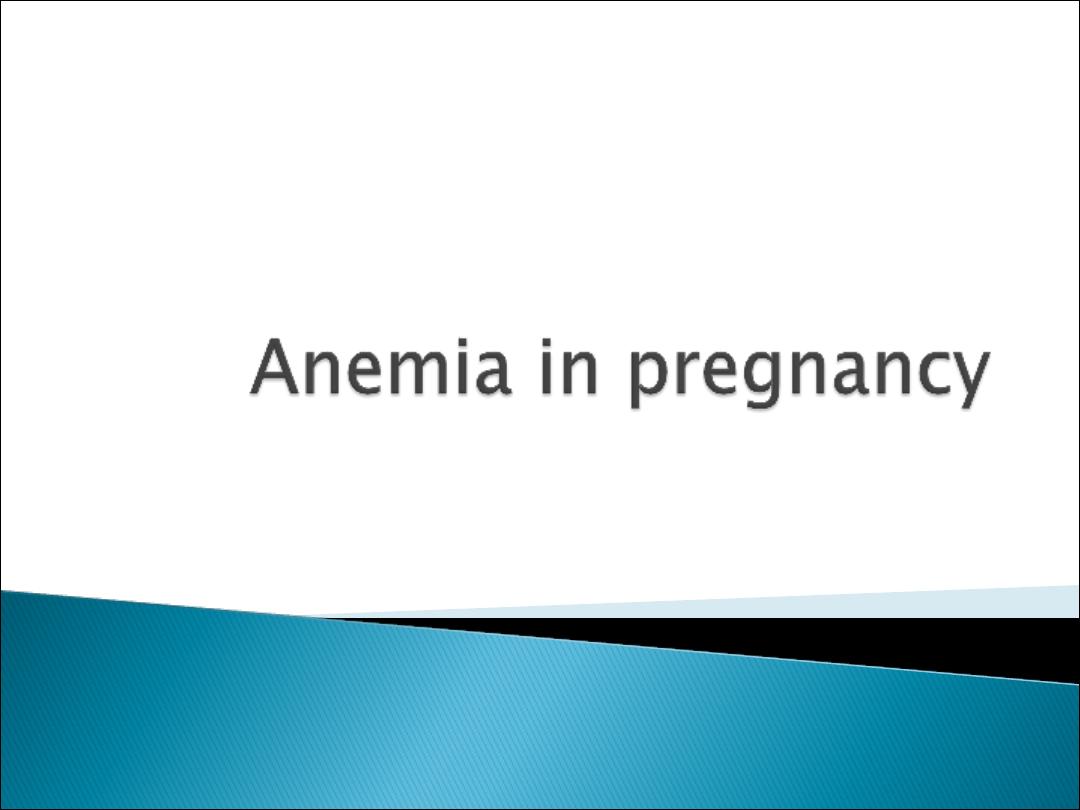
BY Dr. Milal Al-Jeborry
2020

}
To know physiological changes in blood
during pregnancy.
}
To understand definition, types and aetilogy
of anemia in pregnancy.
}
To know how to diagnose and treat various
types of anemia in pregnancy.

}
Iron deficiency anaemia is a significant
problem
}
worldwide, affecting 50% of pregnant women
(56% in developing and 18% in developed
countries).
Incidence is lower in developed countries due
to :-
1.Better living slandered & nutrition.
2.Smaller & better- spaced families.
3.Wide spread use of oral contraception which
usually decrease menstrual loss.
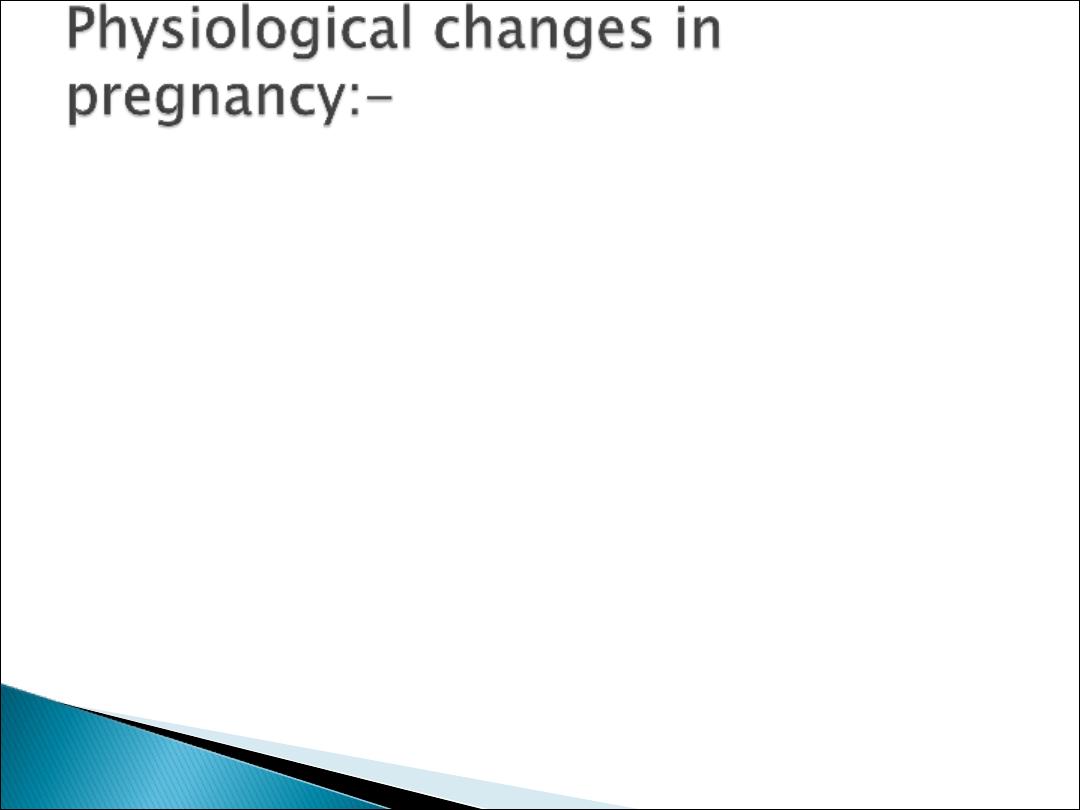
}
Plasma volume increase by 20% by 15 weeks
& 50% by 30-34 weeks (1250 ml).
}
RBC increase by 14% (180 ml) without
supplementation iron & 28 %( 350 ml) when
extra iron & folic acid given.R.B.C mass will
increase due to increase erythropoietin
(possibly due to HPL).
}
Because there is greater increase in plasma
volume than of the RBC this will lead to
hemodilution & physiological anemia.
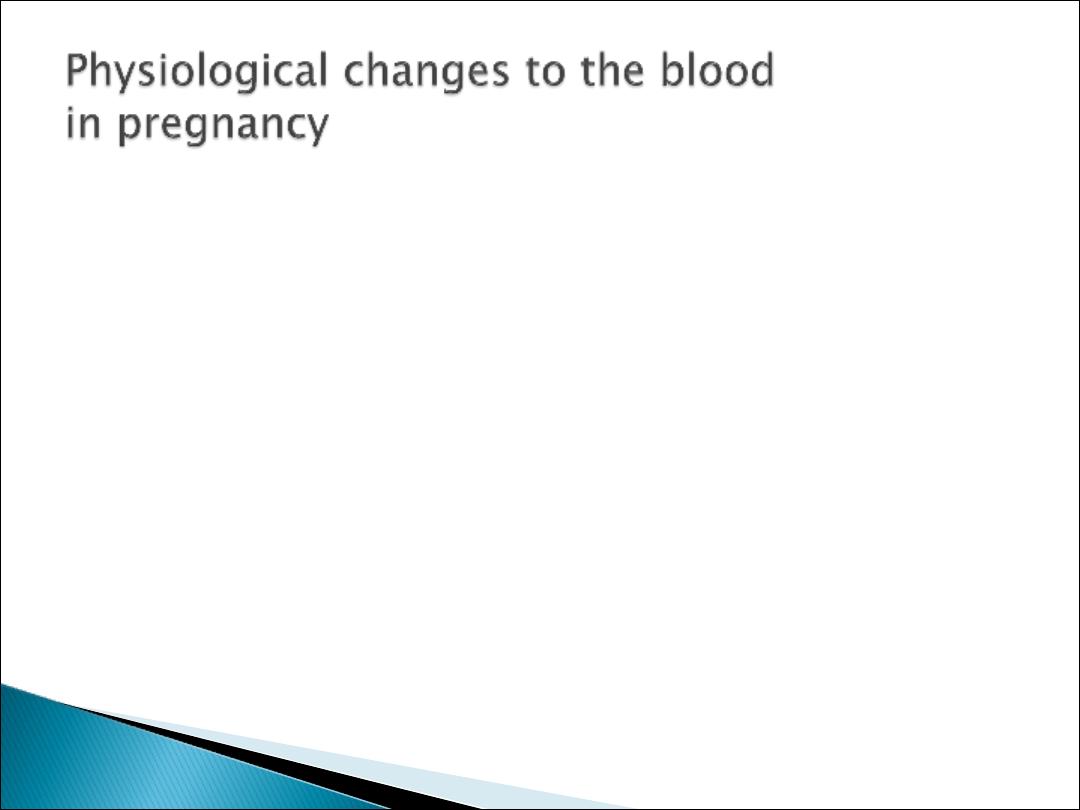
}
(MCV) which increases by about 4–6 fL,
secondary to greater numbers of larger
}
young red cells from the increase in red cell
mass.
}
↑ white cell count: ↑ neutrophils, ↑ monocytes, ↓
lymphocytes
}
Mild thrombocytopenia with no impairment of
platelet function.
}
Prothrombotic state predominantly due to
increases
}
in FVIII, vWF, fibrinogen and reduction in protein
S.
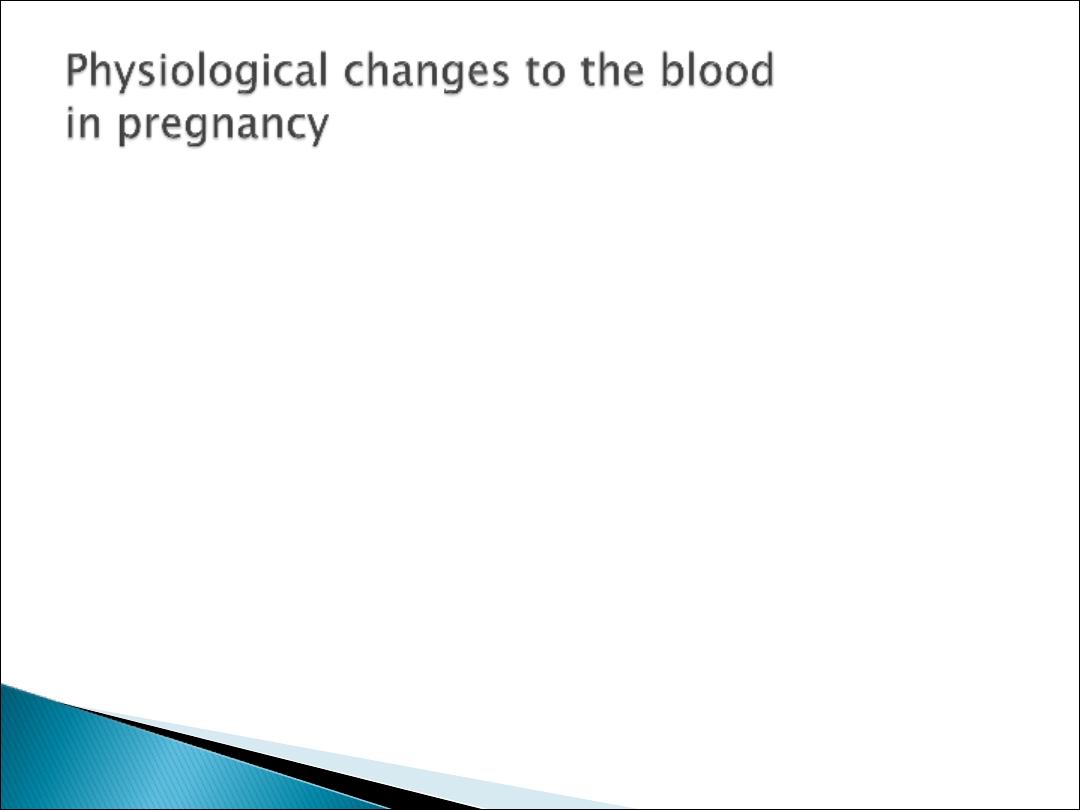
}
Serum folate levels fall by around half, due to
a twofold increase in folate requirements
}
but red cell folate levels are relatively spared.
}
Functional vitamin B12 levels change very
little
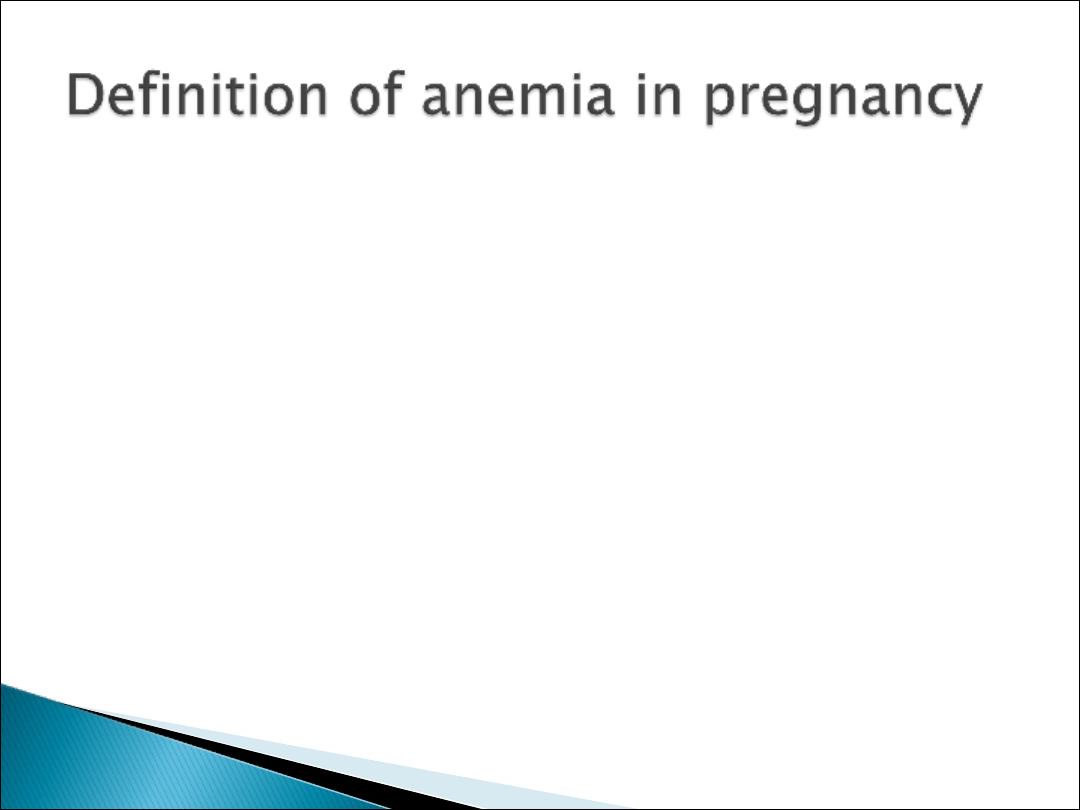
}
The British Society of Haematology
}
(BSH) and the US Centers for Disease Control
and Prevention (CDC) use
}
a value of less than 11.0 g/L in the
}
first trimester
}
but less than 10.5 g/L in the second and
third Trimesters.
}
Postpartum anaemia
}
is defined as Hb less than 10.0 g/L
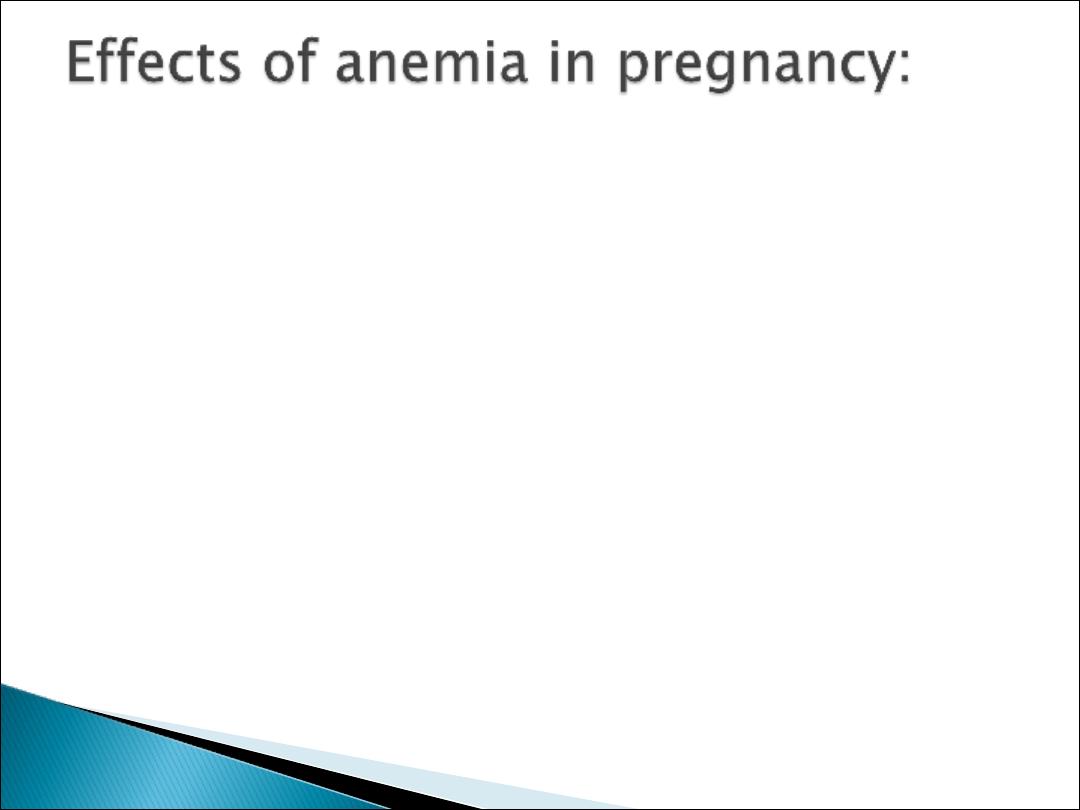
1.↓ ability to withstand the effects of obstetric
hemorrhage.
2. Severe anemia predispose to infection.
3. It may ↑ risk of thrombo –embolism.
4. It predispose to decompensation in mother
with cardiac or respiratory disease. High
output cardiac failure is likely when Hb <
5g%.
5. Delayed physical recovery especially after
c/s & in multipara.

}
There may also be a link between iron
deficiency, low birthweight and preterm
}
delivery but this is, as yet, unproven
}
On the other hand, the effects of maternal
iron deficiency anemia on the fetus are
negligible & the baby has normal cord blood
Hb level
}
as preferential delivery of iron is facilitated by
upregulation of placental transferrin.
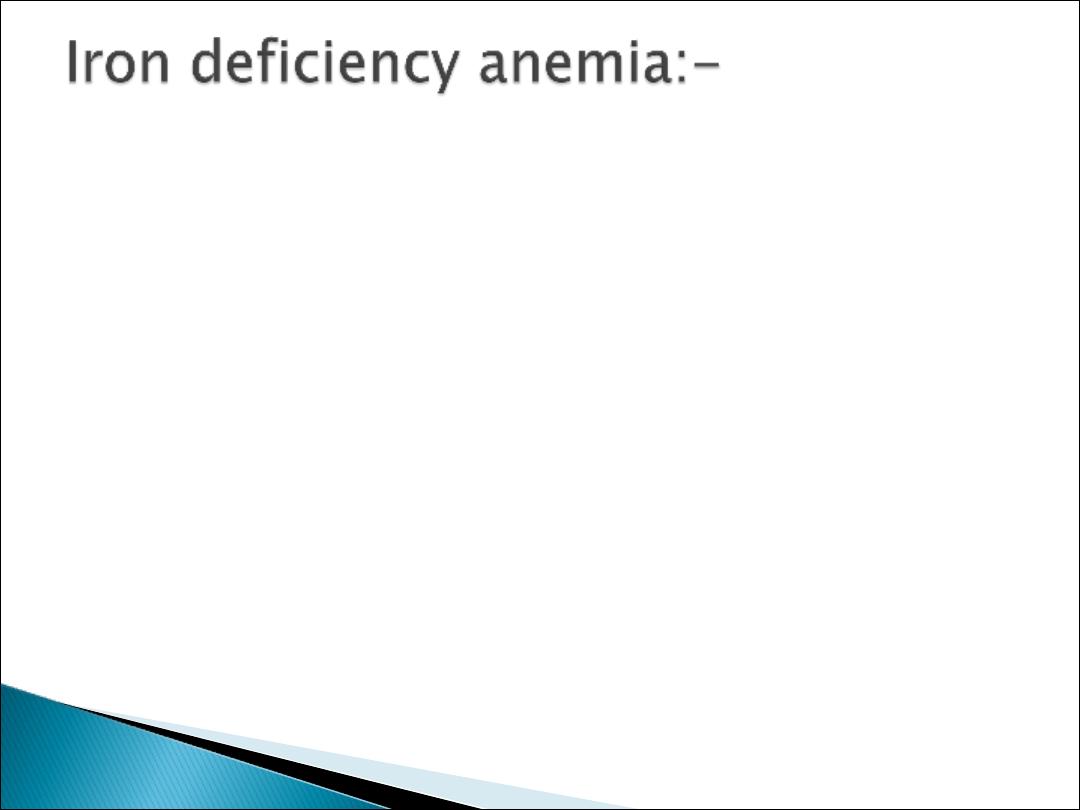
}
80% of anemia in pregnancy is IDA.
}
In non- pregnant women iron requirement is 1
mg/day. During pregnancy there is ↑ iron
requirement about 3.5 mg/day.
}
Fetus, placenta: 500mg iron
}
Increase RBC mass 500mg
}
Postpartum blood loss: 180 mg
}
Lactation for 6 months: 180 mg
}
Total requirement: 1360 mg iron. From this 350
mg may save as a result of amenorrhea of
pregnancy, so the actual demand during
pregnancy is 1000 mg.
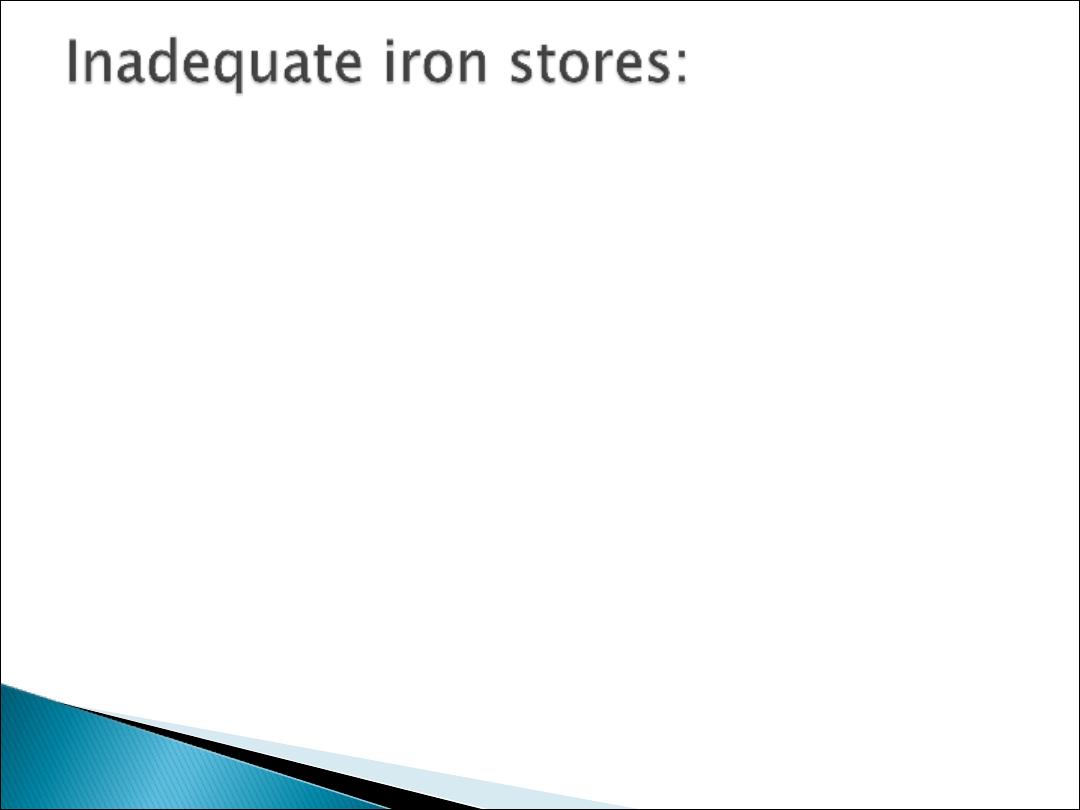
1. Poor intake of iron in diet or poor absorption of
iron.
2. Chronic menorrhagia.
3. Intestinal bleeding due to hemorrhoids or
hookworms infestation.
4. Insufficient interval for replenishment between
pregnancies.
5. Poor utilization of iron by the bone marrow due
to severe or chronic infection.
Clinical features:
Tiredness, breathlessness, palpitation, fainting. In
severe case the patient may looks pale.

1. Hb, pcv% decrease.
2. Blood film: hypochromic microcytic
3. B.M exam .special stain, absence of iron.
4. Serum iron decrease
5. I.B.C increase
6. Serum ferritin decrease below 15 μg/L is
diagnostic.
I.D.A.: serum iron decrease, I.B.C increase, serum
ferritin decrease.
Infection: serum iron decrease, I.B.C increase,
serum ferritin increase

}
The British Committee for Standards in
Haematology (BCSH) suggest the following.
}
A trial of oral iron should be the first
‘diagnostic test’ for women with a normocytic
or microcytic anaemia,
}
with a check for Hb increase at 2 weeks.

1. Prevention:-iron prophylaxis esp. for:
patient with high parity, multiple
pregnancies, history of anemia or
menorrhagia.
A pregnant woman need only one tablet of iron
per day for prophylaxis which usually
combined with folic acid in the same tablet
(100 mg elemental iron +350ug folic acid) as
soon as they are free from nausea & vomiting
of early pregnancy.
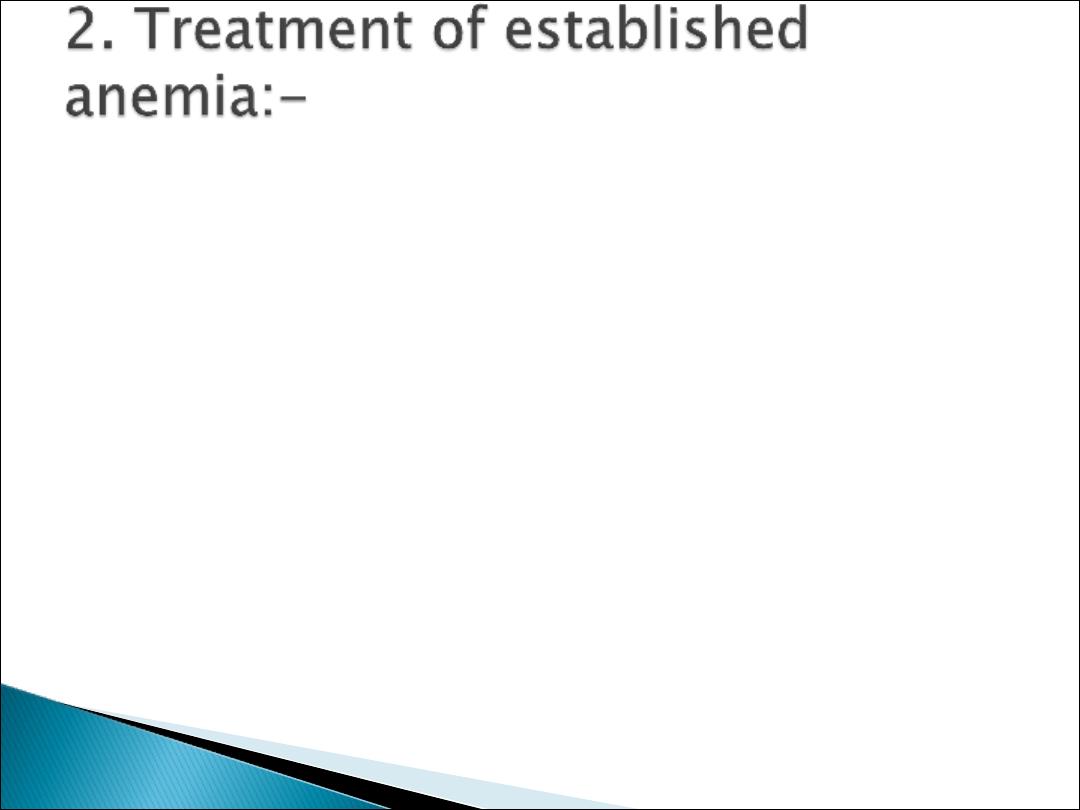
Depend on:
A. severity of anemia
B.Nearness to term
C.Other complications like placenta previa.
Treatment:-
1. Oral iron
2. Injectable iron
3. Blood transfusion.

}
Anemia in early pregnancy is treated with oral
iron. One tablet of ferrous sulfate or
gluconate or fumarate 3 times /day after
meals & the treatment continue for 3-6
months postpartum to full the stores.
}
10-20% of patients undergo GIT symptoms
such as nausea, vomiting, constipation,
abdominal cramps & diarrhea, treatment by ↓
the dose or by giving the pill with the meals
rather than after meals.
}
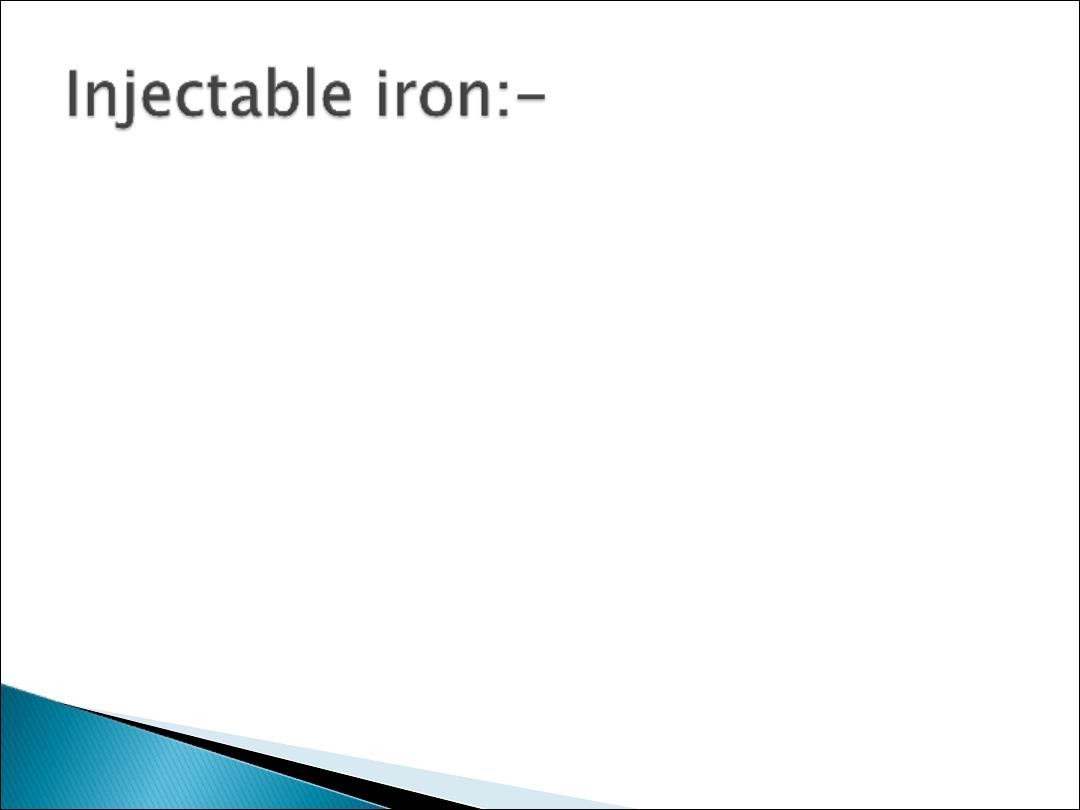
rarely indicated in :
a. Patient have severe iron deficiency anemia (Hb <
8 g/dl, & a few weeks before the expected date
of delivery.
b. patient can not absorb iron (malabsorption
syndrome ).
c. patient develop incapacitating S/E with oral iron.
S/E of parenteral iron:
1. 2% of patients develop acute systemic reaction
such as hemolysis, hypotension & circulatory
collapse.
2. Causes dark staining of the skin & inflammation
at the site of injection.

Calculate iron deficit using one of the following
formula:-
1. Normal Hb –patient Hb× weight (Kg) ×2.2
+1000 =mg of iron needed.
2. 250 mg elemental iron for each 1 gm Hb below
the normal.
Parenteral iron may be given by a deep I.M
injection as iron dextran (imferon) or iron
sorbitol (jectofer). Each of these contains 50 mg
of iron per ml & the patient given a daily injection
of 2 ml until satisfactory response is established.

Iron dextran (but not sorbitol) may also be given by (total –
dose I.V infusion), this method may be useful for women
with severe anemia & who are unlikely to attend for a
series of injections. The patient is admitted to the hospital
for 6 hours & one litter of normal saline containing the
calculated dose of iron dextran is administered by slow I.V
drip.
Follow up: reticulocytes, Hb.
}
newer preparations such as iron carboxymaltose, which
}
is given as a single dose over 15 min, produces a faster
}
response (approximately 1.0 g/L improvement per week)
3. Blood transfusion:-
May be required for treatment of severe anemia near term or
when some other complication such as placenta previa.
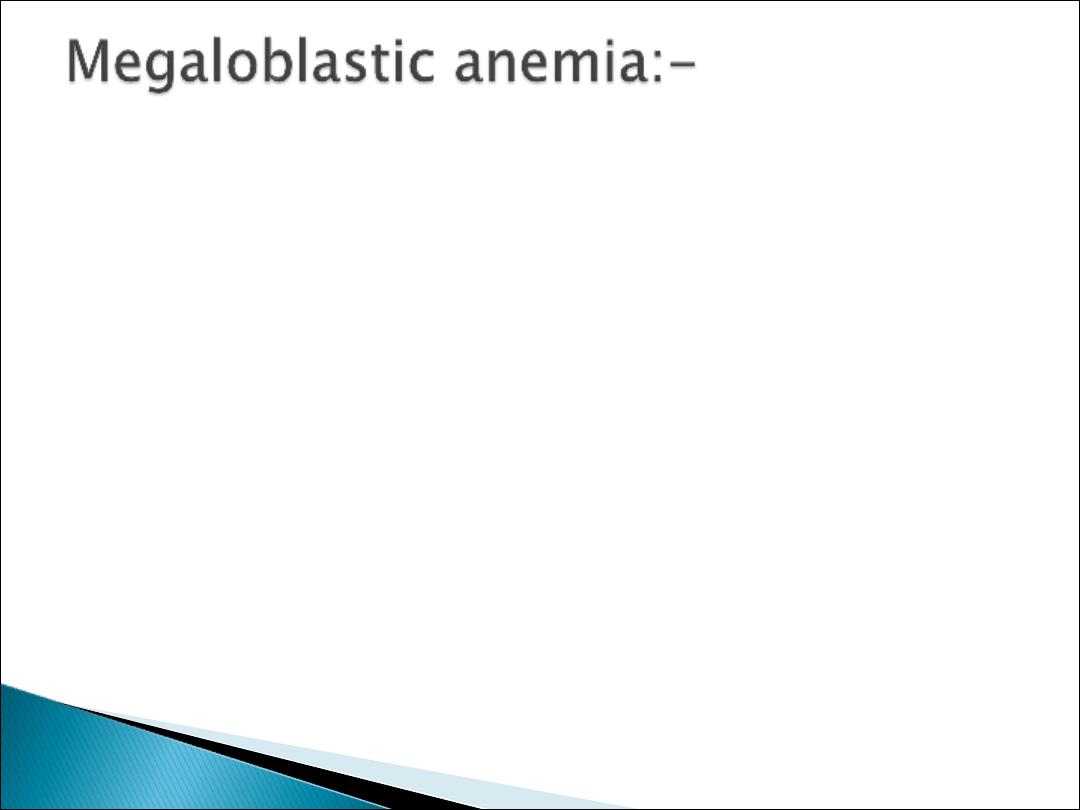
5 % of anemia.
Folic acid requirement: Non pregnant: 50 ug/ day.
Pregnant: 350-400 ug /day.
Causes of folate deficiency:
1. Inadequate dietary intake.
2. Poor absorption (intestinal malabsorption). 50% of
cases e.g. gluten sensitivity; typical recurrence of
megaloblastic anemia in successive pregnancies.
3. Epileptic with anticonvulsant drugs.
4. Multiple pregnancies.
5. Chronic hemolysis from any cause such as sickle cell
disease or B-thalassemia.
6. Impaired utilization of folic acid by B.M e.g.
infection.

}
Presentation is acute; tongue is painful with
papillary flattening, opthous ulceration of
tongue, mouth. May be vomiting, anorexia,
diarrhea, little or no weight gain or even
weight loss during pregnancy.
}
Regardless the severity of maternal folate
depletion, the fetus obtains enough folic acid
for its own requirement & cord blood folate
level being higher than the maternal value at
the time of delivery.

1. Blood film: hyper segmentation of
neutrophils, macrocytes, neutropenia, and
thrombocytopenia.
2. Decrease RBC folate, decrease serum folate.
3. B.M.: megaloblast erythropoisis, disordered
granulopoisis, impaired thrombopoisis.
4. Serum B12 level.
B12 ↓ is rare occur in vegetarian, gluten
enteropathy involving the ileum.

A- Prevention:- folic acid supply for:
Multiple pregnancies, hemoglobinopathy,
anticonvulsant therapy, previous history of
megaloblastic anemia.
}
Patients at increased risk of folate deficiency
should take 5 mg of folate daily as
prophylaxis during pregnancy.
}
Those with established folate deficiency
should take 5 mg three times daily
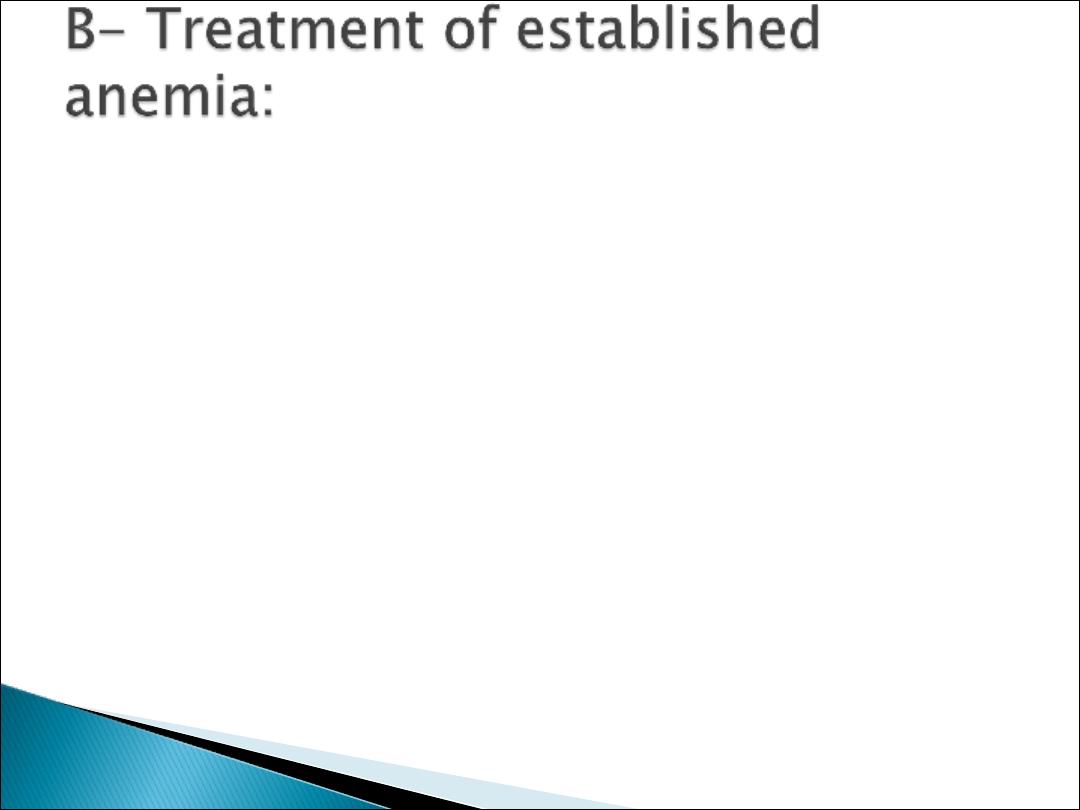
1. Oral folic acid 5mg three times daily.
2. I.M folate: A. impaired absorption of folate.
B. when there is severe
vomiting.
3. Treatment of any infection.
4. Blood transfusion when Hb < 6 gm/dl. When
Hb < 4 gm/dl then exchange blood
transfusion.
5. B12 ↓ rare treated by weekly injection of vit.
B12 1000 ug, should be given as well as folic
acid until after delivery.
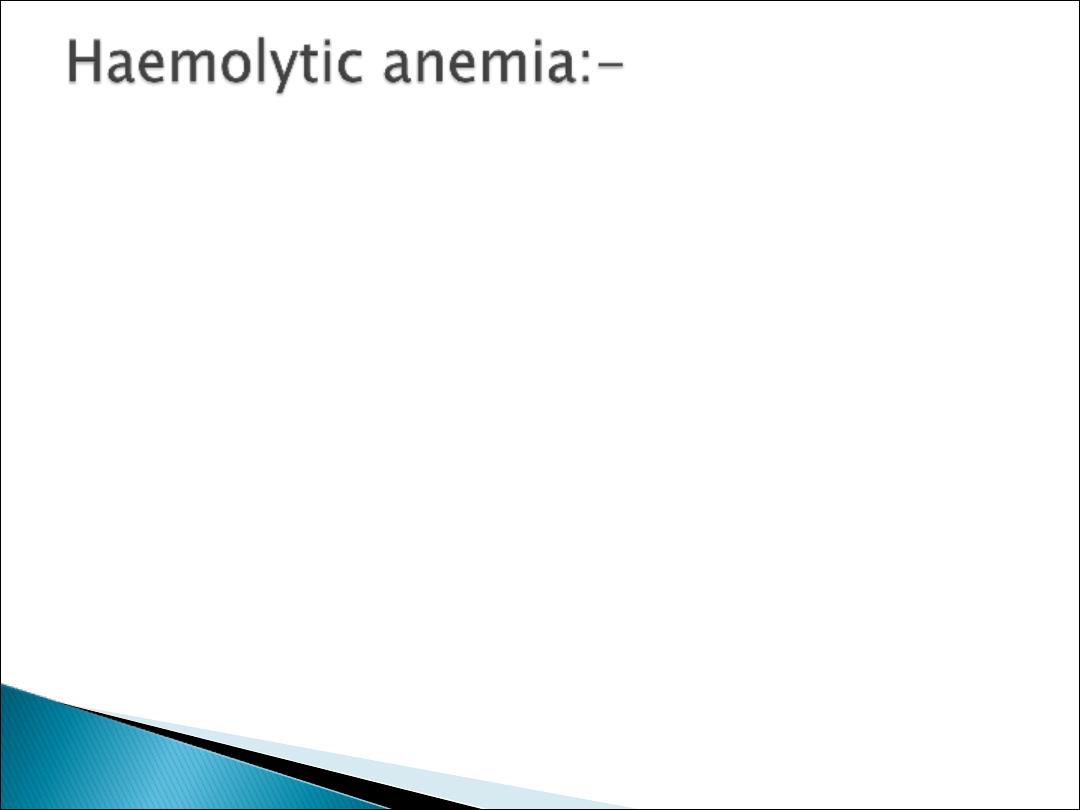
A- Acquired: infection, toxin, poison.
B- Congenital:
1. Spherocytosis & elliptocytosis: autosomal
dominmant, neonatal jaundice.
No significant maternal effects during pregnancy.
Folic acid supplementation double the dose.
2. Enzyme defects Haemolytic anemia:-
G6PD ↓ (sex-linked recessive).
Neonatal jaundice.
Hemolytic crisis: sulphonamide, synthetic
analogues of vitamin k & nitrofurantoin.
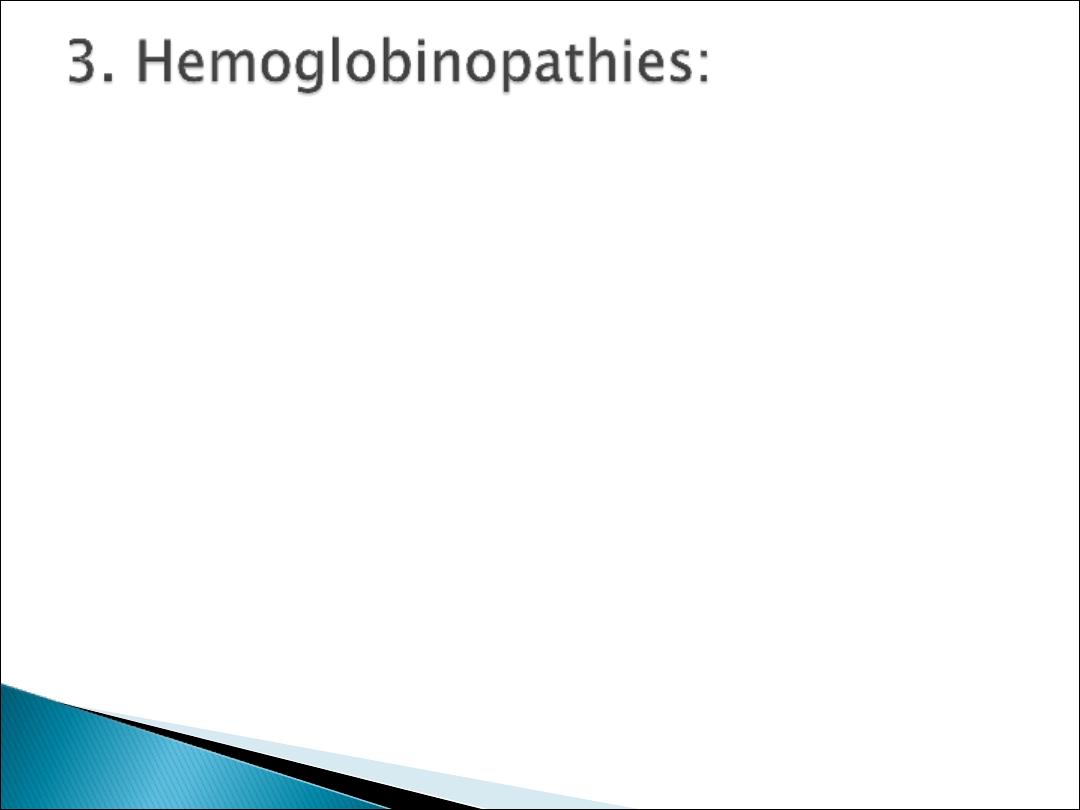
}
Hb A → ᾳ2 B2 (95% OF Hb).
}
Hb F →ᾳ2ᴕ2 (1% OF Hb.
}
Hb A2→ᾳ2 delta2
}
Sickle –cell; syndrome:
}
Autosomal inherited, affecting the blacks.
}
Hbs; abnormality in B chain
}
Homozygous → Hbss (sickle –cell disease)
}
Heterozygous →Hbs (sickle-cell trait)
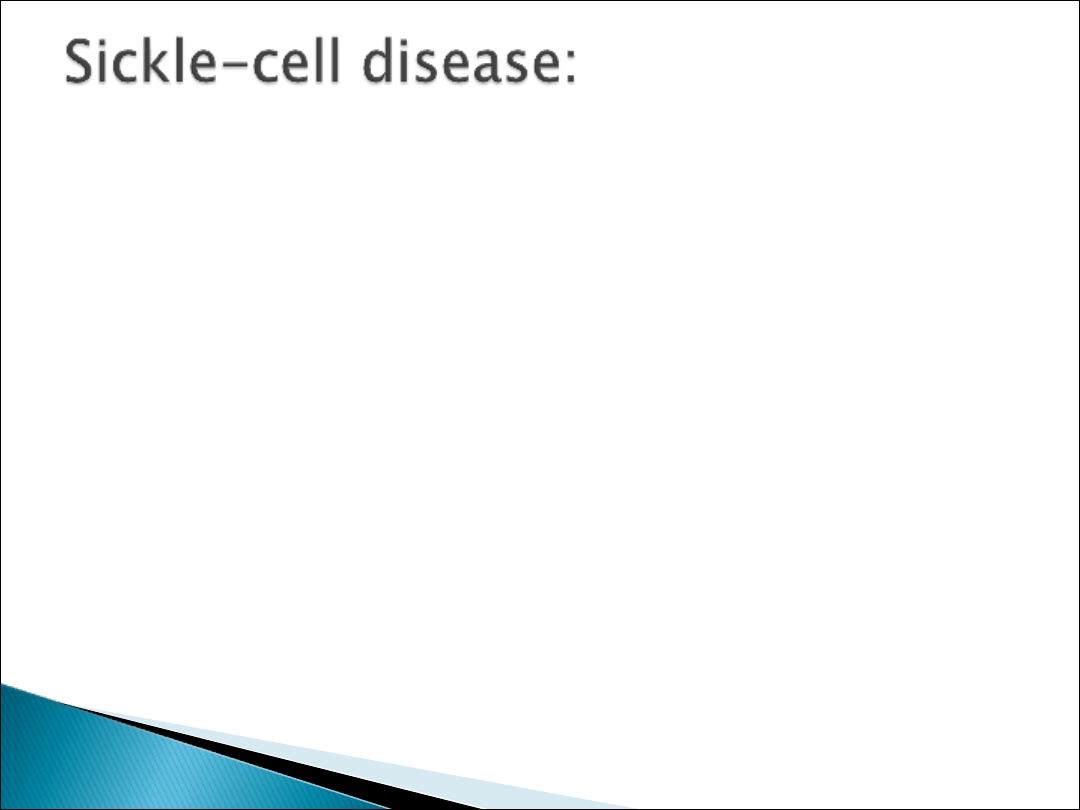
}
Usually fatal in childhood, so rare in pregnant
woman. Low Hb (5-9 g/dl).↑ incidence of
crisis during pregnancy, labour &
puerperium& may be precipitated by hypoxia,
infection, acidosis& dehydration.
}
↑ abortion, stillbirth, prematurity IUGR.
}
Screening by sickledex test; while definitive
diagnosis by Hb electrophoresis.
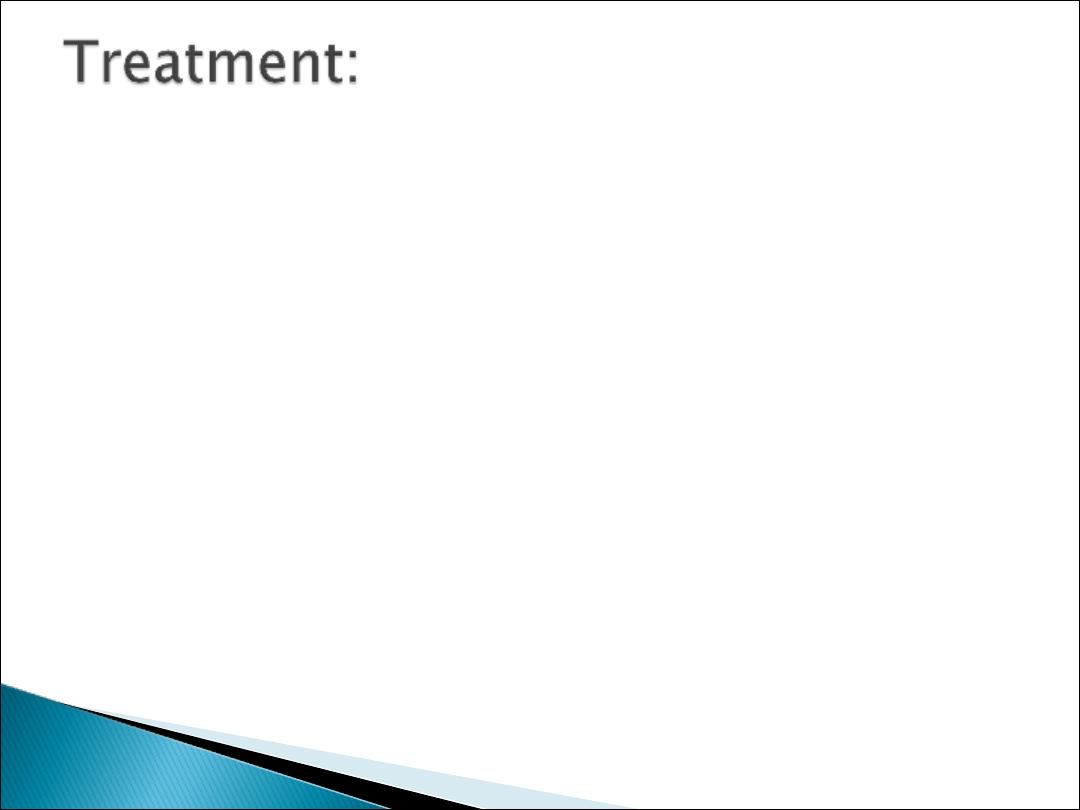
1. Avoid hypoxia, dehydration & acidosis.
2. Treatment of any infection.
3. Repeated blood transfusion throught
pregnancy decrease the likelihood of crisis.
The aim is Hb 10 g/dl.
4. Therapeutic doses of folic acid.
5. Avoid iron
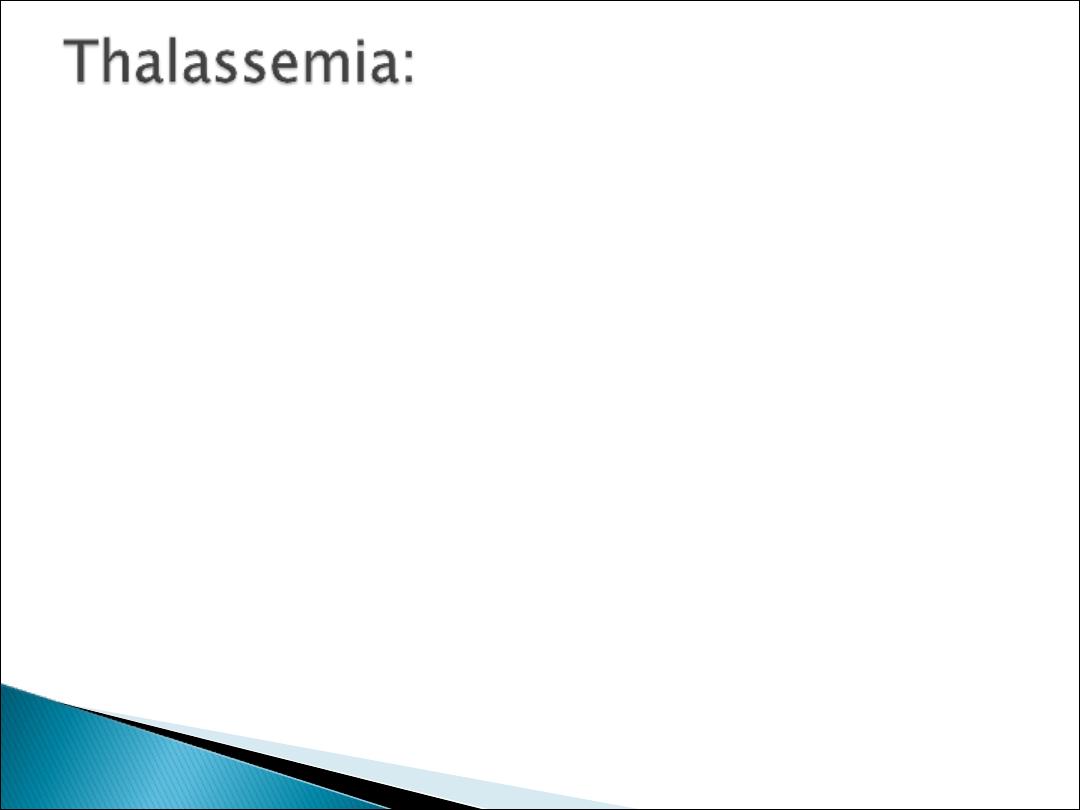
}
There is partial or complete suppression of
either B or ᾳ chain
}
B thalassemia major (homozygous)
}
B thalassemia minor (heterozygous)
}
ᾳ
thalassemia major or minor.
}
Bthalassemia minor affect meditrian, Hb 10
g%, hypochromic microcytic anemia.
}
No ↑ in RBC mass in pregnancy

Diagnosis:
Hb electrophoresis
Treatment:
1. Folic acid supplementation.
2. Avoid iron.
3. Blood transfusion sometime necessary.

}
THANK YOU
